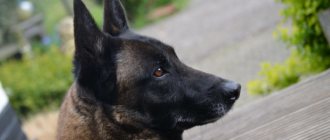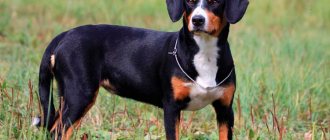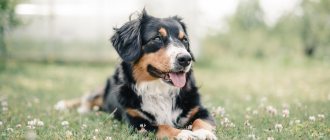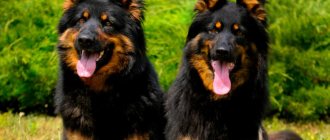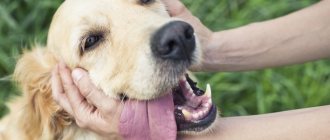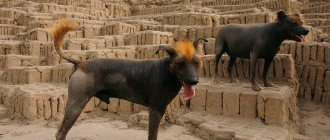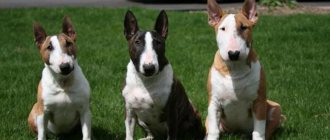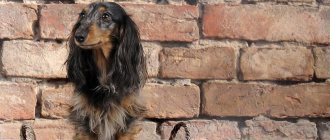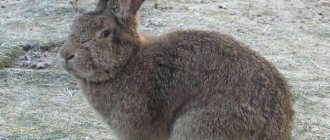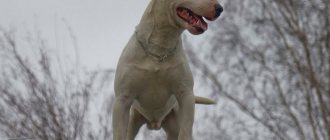The Bouvier des Flandres is a large and strong herding dog with excellent conformation and working qualities. The French name for the breed, Bouvier Des Flandres, translates to “cow herder from Flanders.” In the Netherlands the breed is also known as vuilbaard - "dirty beard". The Bouvier des Flandres is an intelligent, resilient, loyal friend and reliable guard for adults and children.
Brief characteristics of the dog
Other possible names: Vlaamse Koehond, Bouvier de Flanders, Flanders Cattle Dog, Bouvier de Ruler, Picard, Vuilbaard, Bootes. Adult height: 56-71 cm. Weight: 27-54 kg. Characteristic color: black, red, gray, brindle, white, often black with red spots. Coat length: medium length, wavy. Life expectancy: 9-11 years. Advantages of the breed: loyal, intelligent, loves children, balanced, calm, obedient, does not bark over trifles. Difficulties of the breed: likes to dominate, not suitable for novice dog breeders, requires coat care. Average price: from $400.
History of the origin of the breed
The Bouvier des Flandres, like other breeds that were not purposefully bred, has several versions of its origin. But they all boil down to the fact that the homeland of dogs is the medieval county of Flanders, which is located on the border of Belgium and France. Since it existed in the 9th-14th centuries, the version about the origin of the breed back in the 12th century sounds more plausible. This happened thanks to the monks of Ter Duinen Abbey, who crossed Deerhounds and Irish Wolfhounds or Beaucerons. Subsequently, this mixture became the ancestor of many breeds.
According to another version, Bouviers appeared in the 16th-18th centuries and have the genes of Laekenois, Briard and Dutch Longhaired Shepherd. The official date in the history of the breed can be called 1894, when its first written description appeared by the Belgian professor A. Reul. In 1910, Bouviers took part for the first time at an exhibition in Brussels, and in 1912 their first standard was published, updated in 1923. During the First World War, some of the dogs were exported to Germany and subsequently took a direct part in the formation of the Giant Schnauzer. The name "Bouvier des Flandres" was assigned to the breed only in 1928. And in 1937, adjustments were made.
At the same time, French breeders insisted on a light color for Bouviers, while Belgian breeders, on the contrary, wanted to see them only in black. Their disputes were interrupted by the Second World War, during which many large breed dogs died because they were actively used as orderlies and for delivering weapons and food. Bouviers received worldwide recognition in 1965 thanks to the International Federation of Cynologists (FIC). The final standard was approved in 1969. The Bouvier des Flanders is most popular in France, Holland and the Netherlands, as well as in Italy, England, Sweden, Spain, Denmark and Germany. In other countries it is little distributed or completely unknown.
Historical reference
The Bouvier des Flandres dog is a working, herding dog that was not intentionally bred. On farms there is always a place for large four-legged animals performing security and court service. With the development of cattle breeding, the Bouvier of Flanders began to be actively used for grazing cattle and sheep.
The homeland of the breed is the territory of Belgium and France (formerly Flanders), with a climate suitable for raising livestock. However, in spacious meadows, where there is no protection from precipitation and wind, the working conditions are quite harsh. The Flanders Bouvier has evolved to keep up with the demands of farmers. The dog's coat became tougher, the undercoat was denser, even the beard and mustache served for protection. By the way, thanks to the rich vegetation on the face, one of the popular names for four-legged animals sounds like “dirty beard.”
This is interesting! The Bouvier of Flanders was actively used for some time to move cargo, but unlike draft dogs, the four-legged dogs carried luggage in baskets.
Despite the main version of the history of the breed, that the Bouvier of Flanders is an aborigine, there is a document stating that the four-legged animals were bred using selective breeding. In the 50s of the 20th century, a report was published containing evidence that representatives of the breed had lived in monasteries since the 12th century and were subject to deliberate selection. According to this version, the Bouvier of Flanders is not an indigenous breed, but a deliberately bred one . Dogs imported from England became the basis for breeding work.
This is interesting! The Flanders Bouvier, despite its rustic appearance, is actively used for work in the police and intelligence services.
The Bouvier des Flandres is a very hardy dog and has been used to its full potential . One or more four-legged animals lived on the farm, grazed, guarded, helped transport goods, and were busy working up to 18 hours a day. With the development of market (literally) trade, Bouviers of Flanders began to be used for transporting carcasses on carts.
Early individuals were noticeably different from modern dogs, with a great contrast in appearance. Modern representatives of the breed require a certain amount of care and grooming, while early dogs looked more like shaggy giants. Despite their power, the gene pool of the quadrupeds was built on the blood of greyhound dogs , distinguished by strength but refinement. Already at the end of the 20th century, strictly selective selection was carried out. Experts sought to preserve the working qualities of the breed, but give it a more pleasant appearance. The first participants in breeding work were distinguished by their strength, coarse wool, hunting and guarding skills. At the second stage, after obtaining an acceptable exterior, aboriginal Flanders Bouviers were included in the breeding work. Thus, an almost universal herding breed was obtained.
As mentioned above, Bouviers of Flanders were used for cargo transportation. The dog pulled a small cart itself, but there are confirmed facts that representatives of the breed also worked as sleds. For a relatively short time, the rock was also used to work in mills. The dogs were harnessed to millstones that spun in a circle. The four-legged animals walked in harness for 5–6 hours.
Despite a number of hypotheses put forward, official data indicate that before the 20th century, breeding of the breed took place mainly chaotically. However, official sources do not deny that individual bloodlines could be amenable to selection.
This is interesting! During the war and post-war years, the Flanders Bouviers were on the verge of extinction.
The breed standard for the Flanders Bouvier was developed in 1912 and a year later officially adopted in its homeland (the breed is now under the patronage of France). The international standard breed description was approved in 1937. Disputes over the fairness of the requirements and proposals to revise the standard remained relevant until the 50s. It took experts about 10 years to resolve all controversial issues. By 1965, a unified breed standard was adopted.
Description of the Bouvier des Flandres breed
Representatives of the breed are strong, compactly built dogs. They have a short body covered with hard fur. One glance is enough to understand that this is a strong animal, devoid of clumsiness.
According to the standard, dogs are described as follows:
- The head is large, but proportional to the size of the dog, with a flat forehead, the clear lines of the head are emphasized by a luxurious mustache and beard. Between the eyes there is an inconspicuous, frontal groove. The raised brow ridges make the transition from the frontal bone to the muzzle look sharper than it really is.
- The eyes are oval, the iris is dark brown. The look is bold and decisive. The ears are set high and are sensitive to any movement. The ears can be cropped into small, pointed triangles.
- The dog's muzzle is quite wide, well filled, tapering towards the nose, with flat cheekbones and tightly fitting lips. The lobe is black, large, the nostrils are wide open. The mouth is equipped with a full set of strong, large, white teeth, the bite is correct, like a “scissors”.
- The neck is strong, covered with muscles, and widens towards the shoulders. If you look at the dog from the side, you will notice a graceful curve. The body is short, wide, tightly built, but not heavy.
- The chest is wide, descending to the elbow line. The ribs have a good bend and are long. The belly line is moderately tucked.
- Limbs . The front legs are equipped with elbows that fit tightly to the body and short, slightly sloping metacarpus. Placed evenly, parallel to each other, the bones are strong. The hindquarters are strong, well muscled, the hips are wide and strong. The lower leg is of medium length, the metatarsals are shortened, and there is a noticeable plumb line. The paws are round, the toes are long, curved, compressed into a tight ball. The pads are dense, the claws are hard, pigmented black.
- The tail is located high, smoothly blending into the line of the spinal column. The cut is short, leaving only 2-3 vertebrae.
The height of males is 62-68 cm, females vary from 59 to 65 cm, average figures are considered ideal. Shepherds move freely and confidently.
How to choose a puppy
- The puppy must be chosen from the “right” parents, that is, those who have a good pedigree. The more famous the parents, the more expensive the puppy will be.
- Take a close look at the puppy itself. He should be cheerful, playful, and have a beautiful, healthy coat.
- Pay attention to the living conditions and the vaccination card - this way you will avoid possible health problems in the future.
- Take a puppy older than 2 months, then he will already be vaccinated, and his condition and character will be easy to track.
- If you need a pet for exhibitions, then study the breed standards.
Breed standard:
- The head looks large, with a mustache and beard.
- The muzzle is short.
- The nose is black.
- The ears are triangular and protruding.
- The physique is powerful.
- The limbs are smooth, parallel, strong.
- The eyes are dark, medium set.
- The coat is very hard, wavy, with a strong undercoat.
CHARACTER
The Bouvier des Flandres personality is similar to that of other working breeds, although they are calmer. These dogs love people very much, most are incredibly attached to their family. When kept in an enclosure they suffer greatly; they need to live in a house and be part of a family. Known for his loyalty, the Bouvier des Flandres follows his family everywhere, but this is also a problem as he suffers greatly when separated.
They rarely demonstrate their love, preferring to express emotions in moderation. But, even with those they adore, they remain dominant and these dogs are not recommended for beginners.
After World War I, they were kept as bodyguards and military dogs, which contributed to the emergence of a very strong protective instinct. Suspicion of strangers is in their blood and very few dogs treat strangers warmly. They are not aggressive, but protective and, if raised correctly, quite polite. Socialization is very important because without it they can be aggressive.
Sensitive, they can be excellent watchmen, warning strangers with loud and frightening barks. The Bouvier des Flanders is a dog that protects its own and will always stand between danger and its loved ones. They prefer to scare the enemy rather than immediately attack and take threatening poses to drive him away. But, if they need to use force, they don’t hesitate and attack, no matter who opposes them.
They have a good reputation with children. Especially if a child has grown up in front of a dog, then they are very kind and become best friends. Like other breeds, if the dog is unfamiliar with children in general, the reaction may be unpredictable.
But they are not friends with animals and dogs. Almost all are extremely dominant and do not back down from a challenge. Aggression towards same-sex animals is especially strong and both sexes are predisposed to it. Ideally, keep only one Bouvier, maximum with the opposite sex.
Socialization helps reduce manifestations, but does not eliminate them. In addition, these are herding dogs and they instinctively nip the legs of those who do not obey them. The attitude towards other animals is no better; they can attack and kill them. Some are able to live with domestic cats if they have known them since childhood, some are not.
Very intelligent and eager to please their owners, Bouviers des Flandres are excellent to train. They are able to perform in obedience and agility, and learn everything in the world. They say that once a Bouvier remembers something, it never forgets.
However, for many, training will be difficult. These dogs are very dominant and will not blindly obey orders. If they don’t consider a person a leader, then you won’t get obedience. This means that in a relationship you should always take a leadership position, and training should begin as early as possible.
Like other herding dogs, the Bouvier des Flandres needs high activity and daily exercise. Without them, he will develop behavioral problems, destructiveness, and hyperactivity. However, they are much less energetic than the same border collies, and most city dwellers are able to satisfy their demands.
Theses
- Not recommended for beginners as they are dominant and stubborn.
- They get along well with children and usually become best friends.
- Aggressive towards other dogs, they can attack animals and kill them.
- They require quite a lot of care.
- They love their family and should not be kept on a chain or in an enclosure.
The main purpose
As you can see even from the photo, the Bouvier des Flanders is a large, powerful dog. She is strong and strong, knows how to be decisive and subordinate. Her character is characterized by balance and calmness. Thanks to all these features, the Bouvier has been used before and now to catch criminals, as a guide dog, as a security guard, protector and reliable bodyguard. The animal is ideal for those who want to have a reliable, strong and fearless assistant in the house.
The animal is easy to train, gets along well with children, does not require special care and gets along well both in a country house and in an apartment.
The Bouvier des Flandres has a rather intimidating appearance, but at the same time its character is distinguished by its balance and calmness. He is an ideal pet: cheerful, obedient, moderately playful. A dog will be calm towards other pets if it is properly socialized from childhood.
These animals are very smart, have a stable psyche, fearless and strong. With proper training and upbringing, you will get a wonderful pet and at the same time a formidable guard.
Owner reviews
Anton:
The dog is calm and balanced. If you raise her in a timely and correct manner, then she poses absolutely no threat to the family and others. Loves children. Doesn't cause any particular hassle or problems. The disadvantage is stubbornness and a relatively short life expectancy, even with any care.
Alexei:
These dogs really need to be aware of what's going on at all times. In any weather, he tries to climb higher so that he can see and control everything. In general, they are smart, loyal and incredibly calm, even phlegmatic.
Maintenance and care
The Flanders Bouvier is an unpretentious dog, eats relatively little, hardly gets sick, and can live outside even in cold weather. Grooming efforts should be concentrated on the coat. It is advisable to trim the Bouvier of Flanders once every six months. It is important to accustom your pet to this procedure from childhood, since an adult dog will not allow a stranger to approach itself. During trimming, a little grooming is acceptable, but only to emphasize the advantages, to refine the beard, mustache and eyebrows. At home, it is enough to comb the wool 1-2 times a week. The Bouvier of Flanders usually does not have problems with the eyes and ears, but their condition must be strictly monitored. Don’t forget that your pet’s beard and mustache should be wiped after eating and drinking water. You may not be able to keep track of how your dog drinks, but food particles stuck in the beard are guaranteed to lead to skin inflammation. Note! Very rarely, representatives of the breed experience abnormal eyelash growth, which can be overlooked under thick eyebrows. The dog's eyes should be clear, shiny, without redness, otherwise you need to consult a doctor.
Pet care
Apartment rules
Bouviers need intense exercise if they live in an apartment.
The most suitable place for a Bouvier is to live in a private house, but if the owner is willing to provide the pet with sufficient exercise, the dog can be kept in an apartment. Do not forget that this is a working breed. A sedentary lifestyle negatively affects the character of the Bouvier des Flanders, which is reflected in damage to interior items and shoes.
From six months, the dog should run at least 3–4 km daily. The minimum duration of one walk is 30–40 minutes. You need to take your Bouvier outside 3 times daily. Organize a relaxation area for your pet in your apartment. To do this, choose a secluded place away from the passage, heaters and air conditioners, and lay out a mattress for the dog that matches its size.
Key features of hygiene and trimming
The Bouvier's thick coat requires regular trimming.
Brush your pet at least 2 times a week, but it is better to do it daily. To do this, use a slicker brush and a metal comb. You should not bathe your animal often. Once a month is enough. Particular attention should be paid to the haircut. It is advisable to regularly shorten the hair on the lower part of the paws between the toes, on the stomach, under the tail, on both sides of the ears, and on the tail. The covering in the forehead area (up to the occipital protuberance), as well as on the cheekbones (up to the beard line) should be plucked. Thanks to this procedure, the animal's head acquires a square shape. The fur between the eyes is not trimmed, it must be combed over the face.
Important! You cannot shorten the coat too much, as this will disrupt the natural appearance of the Bouvier. It is best to entrust the procedure to a specialist.
If hair gets into the eyes, it can cause inflammation and suppuration. Therefore, you should examine your dog daily. Remove discharge from the eyes with a napkin soaked in weak tea leaves. Once a week, inspect and clean your pet's ears with a damp cotton pad. Monitor the condition of the claws. To prevent your dog from experiencing discomfort, trim them at least once a month. Every week, pay attention to the hygiene of your pet’s teeth, clean them with a special paste and brush.
Important! After feeding, wipe your dog's mustache and beard.
The nuances of proper dog nutrition
The Bouvier's diet should be as balanced as possible
Bouviers are undemanding when it comes to diet. They can be given industrial mixtures or natural products. The dog is fed beef, poultry, sea fish, cereals, vegetables, kefir, and cottage cheese. Boiled eggs are given twice a week. Water must be in unlimited access. You can determine the required amount of food based on your pet’s weight. Young animals under 12 months of age should receive 40 g per 1 kg of body weight per day. After a year, the norm should be reduced by 2 times.
A puppy up to 6 months is fed three times a day. In the future, food is given 2 times a day. Some owners switch adult dogs to single meals. If you prefer to feed your pet special mixtures, choose high-quality premium products: ACANA, Artemis, CANIDAE, Almo Nature, 1st Choice, Happy Dog. These formulations are made on the basis of natural products without the use of artificial ingredients.
Health
Bouvier des Flandres puppies take a long time to grow up, one might say, to mature. Like other large dogs, a pet can be considered an adult by the age of 2–3 years. The average life expectancy of representatives of the breed ranges from 10 to 12 years. Such a short period of time may confuse a potential pet, but giant breeds rarely live longer due to severe stress on the skeleton and heart.
Important! Flanders Bouvier males are allowed to breed at the age of 2 years, females from 3 years old. By the way, due to their size, females come into heat once a year. Puppies gain weight very quickly, which creates certain risks of improper bone formation. These problems are solved by balanced feeding, vitamin supplements, strict control and moderate physical activity. When properly raised, representatives of the breed almost never get sick and remain active until old age. Some dogs experience age-related and hereditary joint dysplasia, heart defects and arthritis.
Appearance
The breed was bred for serious, grueling work, so the purebred Bouvier of Flanders is a large, strong and hardy dog. The power of the representatives of the breed is demonstrated in every step; even when standing still, the four-legged animals behave very nobly, even a little condescendingly.
Against the backdrop of physical strength and impressive size, representatives of the breed are unexpectedly energetic and active.
Males and females differ significantly in appearance . Males behave more confidently, more demonstratively, and have larger heads and proportions. The following limits apply to the dimensions of adult dogs:
- Male: permissible height 62–68 cm; ideal height 65 cm; weight 35–40 kg.
- Female: acceptable height 59–65 cm; ideal height 62 cm; weight 27–35 kg.
When assessing the exterior, the body elongation index is taken into account . Normally, the indicators fluctuate between 103–105 units. A body that is too long, short legs or unnatural proportions are considered serious faults.
At breed shows, attention is also paid to the characteristics of the breed stated by the standard. The Bouvier of Flanders must be loyal, controlled, reserved, resilient, courageous, curious and interested in work. By the way, according to the standard, the breed is a working breed, so to confirm its status it must pass working tests.
Modern representatives of the breed are considered universal “servants”. In everyday life, the Bouvier of Flanders is a guard, a protector of adults and children, and a companion. With appropriate training, the dog copes well with herding, police work and search. Quadrupeds show excellent results in obedience, which played a significant role in their popularization.
Breed standard
- The head is large, proportional, a little rough. The silhouette is emphasized by eyebrows and mustache. The forehead is wide, powerful, separated by a shallow furrow, and blends very smoothly into the muzzle. Upon examination, the transition to the muzzle looks sharp, but this visual effect is given by the eyebrows. The forehead and muzzles are on parallel lines. The forehead is 1/3 longer than the muzzle. The cheekbones are strong, but dry and not protruding. The facial part is proportional, powerful, wide, with powerful jaws. The bridge of the nose is without humps or irregularities, only the nose has a slight slope. The jaws are equally well developed, hidden by thick, elastic lips.
- The teeth are large and very strong, tightly set, powerful. A correct bite is preferable, but a straight bite is also acceptable.
- The nose is rounded, with very wide nostrils. The lobe is comparatively wide, which is due to the bevel of the bridge of the nose. The pigmentation of the nose, eyelids, lips and visible gums is black.
- The eyes are large, round, expressive, bright, set wide and not very deep. The color of the irises is the most saturated, dark brown. The look is confident, calm, sometimes curious, but always friendly. A heavy, piercing, evil look, like light pigmentation of the irises, is a vice. The eyelids completely hide the white of the eye and the conjunctiva and are pigmented black.
- Ears are set high and wide. The breed standard allows docking to a triangle shape. Cropped ears are extended and placed vertically. When docking, it is important to maintain proportions, which requires some experience in handling the breed. The proportions of the puppies are disturbed, which creates a certain risk. Uncropped ears are set high, refracted and drooping to the sides. The line of the fold (fracture) should not rise above the forehead. The shape of uncropped ears is round, while cropped ears are pointed. In their natural form, the ears are triangular, not too long, and pressed tightly to the head.
- The body is powerful, well-built, proportional. The neck is well muscled, without dewlap, with a pronounced scruff, set proudly, vertically, significantly widening towards the shoulders. The withers are powerful, but not too high. The body is muscular, not too stretched. The back is powerful, fairly wide, but short. The loin is muscular, slightly rounded, the croup is very smoothly rounded. The croup of a male is comparatively narrower than that of a female, and regardless of gender, it is well muscled and powerful. The chest is oval, deep, spacious. The ribs are oblique, convex, but not barrel-shaped, drawn back. The groin line is short, slightly tucked; in bitches, slight stretching is allowed.
- Limbs – smooth, strong, muscular. The shoulder blades are strong, not long, with well-developed muscles, not heavy. The shoulders are strong, slightly sloping. The elbows are pressed to the chest, parallel to the body. When moving, the elbow swing is free. The wrists are strong and vertical, the pasterns are short and slightly inclined. The hind legs are even, when viewed from behind, smooth, with pronounced muscles, the range of movement is free. The thighs are well developed, wide and long, slightly pulled back when standing. The knees are very powerful, the shins are slightly inclined and strong. The pluses are dry, strong, round. The hock joints are slightly let down, strong and flexible. The brushes are powerful, compressed, rounded. The fingers are long, but arched, and the pads are strong. The claws are thick, black, strong. Dewclaws are removed.
- Tail – docked in the first days after birth. According to the standard, the length is left at 2–3 vertebrae. A natural tail in non-working dogs and in countries where surgery is prohibited is not a fault. Standing at the level of the spine, it rushes high.
Raising a Bouvier des Flandres puppy
You have a Bouvier des Flanders puppy
. Where to start raising him? It's simple, first, stop your puppy from jumping on your feet and chewing on your things. This can be done very simply; the puppy will be weaned off toys from gnawing, but it’s more difficult to wean the puppy off from jumping. First of all, pretend that you are ignoring the dog. Don't look or talk to her when she jumps on you. The puppy will understand that this game is not interesting to you and over time will stop pestering you.
Raising a Bouvier des Flandres
definitely necessary. These are guard dogs, so if you do not educate and train them, you will end up with a large and completely uncontrollable dog. To begin with, you should accustom your pet to the place. Then be sure to take your dog through a general training course. This is mandatory because the dog must be absolutely controllable.
Once you have mastered the general training course with your pet, you can move on to special courses.
These dogs make excellent guards and bodyguards. They say that training these dogs requires a steady hand with a suede glove. These dogs are quite easy to train, but they have one unpleasant character trait. They are slightly inclined to independence. Therefore, subordinating the dog to your will is the first task of education.
Where to buy a Bouvier des Flandres puppy?
In our country, these dogs are not very popular, so you won’t be able to easily find a kennel or breeder. Modern technologies will come to your aid in this matter. As you may have guessed, we are talking about the Internet. Here you can find information about Bouvier des Flanders kennels
on the territory of the Russian Federation and about private breeders.
There are several clubs for lovers of these dogs in the country, so information and a puppy are available if desired. Buy a Bouvier des Flandres puppy
you can for about 20-25,000 rubles, provided that you buy the dog second-hand.
Bouvier des Flandres price
in the nursery it will be slightly higher, and nothing can be done about it. In a kennel, such dogs cost about 30-40,000 rubles, depending on the name of the kennel and the puppy’s parents.
So, the Bouvier des Flandres is a very interesting and rare dog in our area. Moreover, puppies of this dog breed are not very expensive. Apparently this is due to the unpopularity of the breed. These dogs are very loyal to their owner and are easy to train. These dogs are suitable for people who do not lead a sedentary lifestyle and have a large family. Dogs of the Bouvier des Flandres breed
They just love communication.
Advantages and disadvantages
Learn more about why the Bouvier des Flandres breed is attractive and what its disadvantages are.
Advantages of the breed:
- A very intelligent dog that can be an ideal companion for a farmer or an active young man.
- He considers his family to be his herd, so he will not allow, for example, children to “scatter” in different directions.
- You won't find a better security guard.
- Unpretentious in food.
- One of the healthiest breeds in the world.
- Suitable for living outside the home.
Flaws:
- A stubborn character will not be able to get along with a weak-willed person, because he will begin to dominate him.
- It’s not easy to keep - size, wool, walking - all these are not the easiest aspects that are not suitable for everyone.
- Predisposition to joint diseases.
How this breed gets along with other animals is a very interesting question. Perhaps you know? It would be interesting to listen. Write in the comments and share your experience.
Nutrition
Many breeders feed their pupils dry food; they believe that special ready-made food contains all the necessary nutrients, vitamins and microelements, and is also well absorbed by the dog’s body. If the food is of high quality, without chemicals, dyes and preservatives, and not lower than the “premium” class, dogs will not experience digestive difficulties. In addition, this type of feeding does not require additional vitamin and mineral supplements. The feeding regimen is important.
At first, puppies need to be fed about five times a day; from six to ten months, puppies are fed four to three times a day; from ten to twelve months, 2 times a day. Starting from 1 year of age, the dog is switched to one meal a day. If you decide to feed your dog natural food, remember that it must be fresh, high quality and without chemical additives. The main product is meat. Fermented milk products, fish and offal are also useful. Don't forget about vegetables and fruits. You cannot feed your pet sweets, pickled and smoked foods, semi-finished products, canned food, cereals (except buckwheat, rice and oatmeal), potatoes, and tubular bones. Food does not need to enhance its taste; it does not need to be salted or spiced.
Training, training
To train this dog, it is best to use the services of a professional dog trainer.
However, if you decide to raise your pet yourself, then you should remember a few rules for training these dogs. The Bouvier des Flandres needs the owner's firmness and confidence in his actions. The dog is easy to train, but can sometimes be stubborn. You must be persistent, patient and strict. Bouvier must understand who is boss. Otherwise it will be quite difficult with him. If the dog grows up in an urban environment, provide it with a lot of physical activity, as this is a working dog that needs mental and physical activity. The Bouvier des Flandres is a shepherd, which means it needs a lot of time in the fresh air. Bouvier is a wonderful friend who loves an active lifestyle in any weather. If you need a bodyguard or tracker, this dog would be a good choice. With him you will not be afraid for your children and yourself, because the Bouvier will always be able to protect both you and himself.
Mating
In a litter, Bouvier des Flandres bitches give birth to 6 to 9 puppies. Pregnancy lasts from 63 to 72 days. Signs appear in the third week. On days 21–22, small hard round lumps can be detected on both sides of the dog’s abdomen using your fingers, which can be palpated until day 35. With the onset of the fifth week, the bitch’s mammary glands enlarge, and in the sixth week, the belly enlarges. A few days before giving birth, it goes down.
A pregnant dog needs a lot of protein. During the first month, the bitch is fed as usual. Further, her diet is based on meat, dairy products, eggs, and fish. The amount of food is doubled.
Important! The bitch should not be overfed. If she gains excess weight, it will complicate the birth process. When feeding with industrial formulas, switch the bitch to a special formula for pregnant women.
In the first half of pregnancy, there is no need to change your walking routine. Then, as the belly increases, the dog itself will refuse to walk for a long time. The bitch should not go up and down stairs or make sudden movements. Don't let her sit on a cold floor.
You need to take care of the place for childbirth in advance. Prepare for this purpose a box corresponding to the size of the dog, a puppy box, diapers, a heating pad, thread, scissors, and disinfectant.
With the onset of the last days of pregnancy, do not leave the bitch unattended. Before birth approaches, she becomes restless, whines, scratches the floor, tears up the bedding, refuses food, and spins around in one place. The dog's body temperature drops to 36.5–37 °C. She begins to have mucous discharge. At the same time, the bitch takes a lying position, presses her back against the box and rests her paws against the wall.
The first puppy is often the largest, so its birth is more difficult than the birth of other cubs. They usually come out with their heads forward and their backs up. The puppy appears in the amniotic sac, which needs to be torn. Then you should remove the baby and cut the umbilical cord at a distance of 2-3 cm. But if the dog wants to do this on its own, there is no need to interfere with it.
If bleeding occurs, tie the umbilical cord with a thread. Wipe the puppy with a napkin and place it next to the bitch. She will begin to lick the baby, which will help stimulate his blood circulation and breathing. After the puppy is born, the placenta is expelled. If the afterbirth does not come out, you must contact a veterinarian, otherwise the dog will die. The bitch also requires medical attention if the interval between the birth of puppies exceeds 2 hours.
Characteristic diseases of the breed and vaccination schedule
Diseases that are common in Bouviers de Flanders include hip dysplasia and volvulus. But they rarely have problems with their well-being; they are a fairly healthy and hardy breed. Vaccination will help protect your pet from infectious diseases. Timely vaccinations help prevent the occurrence of rabies, parvovirus enteritis, canine distemper, parainfluenza, Lyme disease, leptospirosis, and coronavirus.
Vaccination is carried out in the following order:
- at 6–8 weeks of the puppy’s life;
- after 2 weeks after the first vaccination;
- at the age of 6 months;
- every year.
The dog must be dewormed 10–14 days before vaccination. The animal is given one of the following drugs: Drontal Junior, Dirofen, MilbeMax. Even small puppies should undergo this procedure, as infection can occur in utero or through feeding through milk.
It takes some time for the immune defense to develop. Therefore, for two weeks after vaccination, avoid contact of your pet with other animals.
